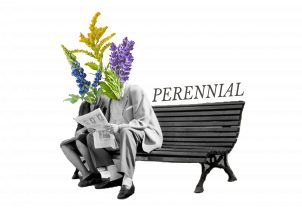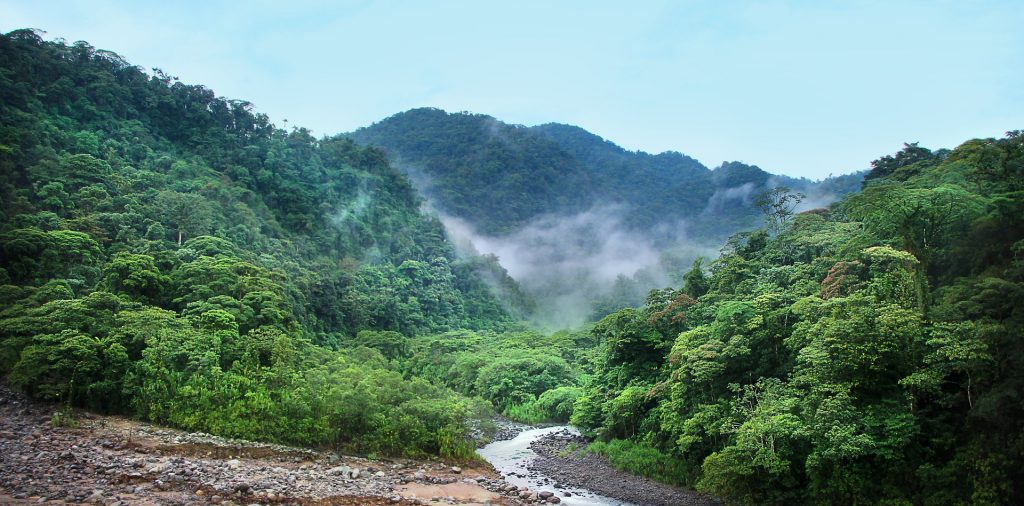It’s another beautiful day in Northern California, and you’re sitting on the beach, basking in the sun’s rays. Reaching inside your cooler, you pull out a cold Yerba Mate and crack it open, savoring the satisfying pop of the can.
Your experience is not alone; Guayakí’s Yerba Mate is gaining popularity, having become a household name in recent years. What isn’t as well known is the production process behind the drink—a socially and ecologically regenerative way of producing yerba mate.
With the founding of Guayakí in 1996 on the Cal Poly San Luis Obispo campus, Alex Pryor—along with Californian David Karr—introduced the “drink of his people,” Argentinian yerba mate, to the local community. Yerba mate is considered a healthier form of consuming caffeine and is largely seen as being healthier for the planet too. Seeking to combat the issue of deforestation, South American grown mate leaves are cultivated alongside the existing rainforest. Shade grown yerba mate defies the conventional ideas that come to mind when thinking of a plantation. Instead of clearing away broad swathes of rainforest that are rich in biodiversity, growing yerba mate under the shade of trees in the rainforest helps preserve the existing flora and fauna, establishing a harmonious, rather than destructive, relationship with nature.
Guayakí offers a market-driven solution to the pressing issue of deforestation. Globally, the total tree cover loss from 2015-2020 was about 10 million hectares. Looking specifically at the Atlantic rainforest in South America—which is where Guayakí Yerba Mate is grown—over 92% of the forest has been lost in the past century. Many rainforest protections have been dismantled by political pressure, as deforestation is considered economically advantageous. Shade grown yerba mate, however, can provide an incentive to maintain forest cover. Although it is not a perfect solution, regenerative farming contributes to the preservation of the natural rainforest.
The Guayakí business model has harnessed the driving power of the free market to help steward and restore over 174,000 acres of South American Atlantic rainforest. By maintaining a symbiotic relationship with these rainforests, the company is contributing to carbon sequestration in forests and soils, as well as protecting natural water supplies and rainforest biodiversity. Deforestation is a strong contributor to anthropogenic climate change and tackling it in novel ways, such as in combination with business, may help address this issue.
Gretchen Gani, Guayakí’s Regeneration and Sustainability Lead, discussed the importance of environmental awareness in a business model. Speaking to the issue of sustainability, Gani said, “corporations need to contribute to regenerating communities and ecosystems. . . we can’t leave it up to the government and nonprofits.” A number of social and environmental principles enable Guayakí’s model of market-driven regeneration.
“We have locked regeneration into the way we do business. . . [Guayakí] meets high standards for sustainable government, treatment of workers, community, and environment,” explained Gani. One possible reason that Guayakí has grown to household recognition is that “consumers want to feel good about their purchases.”
Of course, as with the majority of sustainable business models, there are barriers to reaching complete sustainability within Guayaki’s model. Latin America is an export-based economy, mainly shipping agricultural and mining exports. As a result, many of their products are transported to other countries, releasing greenhouse gas emissions. When looking more closely at greenhouse gas emissions across the agricultural supply chain, most emissions come from land use changes (such as deforestation) and farming. Other aspects are proportionally smaller, with emissions from processing (4%), transport (6%), retail (3%), and packaging (5%). It’s important to note that the type of product purchased, rather than how far away it’s sourced from, is likely to have the most impact on the carbon footprint of an agricultural import.
Guayakí has addressed some of these issues with their distribution emissions. Currently, about half of their shipping fleet is electric, while the other half still runs on traditional fossil fuels. There is still progress to be made in an imperfect model of sustainability, but there’s a clear focus on environmentalism within Guayakí.
Looking at another brand with sustainable practices, Patagonia, we find many similarities. This clothing brand was founded in 1973 by Yvon Chouinard, who has incorporated a message of environmentalism into the company since the start. Patagonia gained popularity due to the quality of its gear and clothing, which are suited for the outdoors, and for its sustainable business model.
Currently, 64% of the clothing materials are made from recycled fibers. All of the cotton grown for the clothing line is organic, saving water and reducing CO2 emissions by 45% compared to conventional cotton farming. Also, over 550 farmers are part of Patagonia’s Regenerative Organic Certification pilot programs, which encourage switching to organic and low-till practices that build healthy soil and draw carbon back into the ground. Regenerative farming aims to rehabilitate soil, respect animal welfare, and improve the lives of farmers.
In 2002, Chouinard co-founded the non-profit 1% for the Planet. Patagonia was the first company in the world to donate 1% of its annual net revenue to nonprofit organizations that promote conservation and sustainability which has amassed to a total of over $116 million since they began. Currently, the nonprofit has over 3000 members pledged to the cause and over $270 million have been raised to help the environment.
In 2013, Chouinard launched $20 Million and Change, which is “an internal fund to help like-minded, responsible start-up companies bring about positive benefits to the environment.” Chouinard detailed the inspiration for creating this holding company in his announcement letter, writing, “economic growth for the past two centuries has been tied to an ever-spiraling carbon bonfire. Business—and human—success in the next 100 years will have to come from working with nature rather than using it up.” This sentiment is reflected in the company’s goal to use 100% renewable and recycled raw materials by 2025. Additionally, Patagonia has succeeded in using 100% renewable energy for its operations in the United States.
A common thread between both Guayakí and Patagonia is their focus on fair trade labor and providing workers with a living wage. This is an area that Guayakí has emphasized, with the company providing over 850 living wage jobs to Indigenous people and small-hold producers in Brazil, Paraguay, and Argentina by 2020. Receiving, in some cases, double the market price for shade-grown yerba mate, producers are guaranteed a living wage while also maintaining the ability to steward and restore their land. In these communities, the sale of yerba mate sustains over 180 families with many of them gaining better access to healthcare and education as a result. This is just one example of market-driven regeneration, as some of the profits from Guayakí’s Yerba Mate are invested in these communities.
In the case of Patagonia, we see a clear level of transparency and a focus on improvement in the treatment of their workers. By 2020, 49, 200 factory apparel workers earned a Fair Trade premium for their labor for the company. Additionally, around 82% of the clothing line is Fair Trade sewn, which impacts over 72,000 workers.
However, based on a recent assessment of their entire assembly, only around 35-45% of the apparel assembly factories for Patagonia are paying their workers a living wage. The majority of their products are made overseas in 14 different countries, including Vietnam, Sri Lanka, and China. Although these workers may earn the minimum wage in their respective countries, this typically isn’t enough to afford adequate food, water, housing, healthcare, education, transportation, childcare, and other essential needs. At the same time, however, one of Patagonia’s mission statements is “Providing a Supportive Work Environment.”
In their most recent Benefit Corporation Report, the company stated, “Patagonia has made the commitment to confirming that living wages are paid to all workers making our apparel by 2025.” This would require paying higher wages to the 65% of their apparel workers not currently receiving a living wage. Although an ambitious goal, if it’s accomplished within the span of a few years, improvements in the lives of their workers could serve as a model to other companies.
In recent years, sustainability has become an important factor in the minds of many consumers. Companies such as Guayakí and Patagonia have thrived in response, taking on environmental issues as their own responsibility. Patagonia’s Yvon Chouinard believes in the idea of corporate action: “businesses have a responsibility to the planet, we all do.” And Guayakí’s David Karr hopes to encourage the action of others: “the greatest influence we’re going to have as a tribe or as a collective is to inspire rather than to have to do it all ourselves.”
Sources:
- https://guayaki.com/global-regeneration/
- http://www.patagoniaworks.com/press/2014/5/5/patagonia-launches-20-million-change-
- https://www.birdlife.org/americas/news/fancy-mate-only-if-shade-grown
- https://rainforests.mongabay.com/amazon/amazon_destruction.html
- https://www.krannert.purdue.edu/faculty/hummelsd/papers/YJEEM-1749_FINAL082312.pdf
- https://www.arcgis.com/apps/Cascade/index.html?appid=a4f7041abe0d400cbcf25d0f6c3f1b28
- https://ourworldindata.org/food-choice-vs-eating-local#:~:text=Transport
- https://www.patagonia.com/hidden-cost-of-clothes/
- https://magazine.calpoly.edu/spring-summer-2018/cultivating-change-guayaki-21-years-later/
- https://goodonyou.eco/how-ethical-is-patagonia/#:~:text=A%20high
- https://medium.com/climate-conscious/what-makes-patagonia-a-world-leader-in-sustainability-
- https://www.patagonia.com/on/demandware.static/-/Library-Sites-PatagoniaShared/default/
- https://guayaki.com/wp-content/uploads/2020/05/Guayak%C3%AD-Impact-Report-2019-Web.pdf
Mina Burns (she/her) is a first year student majoring in Environmental Sciences with an intended minor in Data Science. She is passionate about environmental issues and researching topics such as climate science, intersectional environmentalism, sustainable agriculture, and ecology. Some of Mina’s hobbies include playing violin & ukulele, reading, painting, and getting boba.

